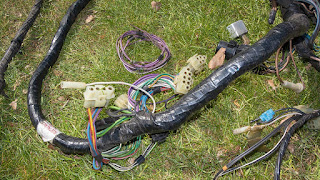Managed to spent a few hours on the car’s restoration
over the weekend. On one of those less interesting jobs, cleaning the chosen
body harness (RKC 3630) and checking the various connectors. I wasn’t looking
forward to this job as it meant removing a fair amount of old glue and wax oil.
I especially disliked removing the old glue. Luckily the chosen harness wasn’t
too badly smeared with the stuff.
And while I was visiting a friend he advised me
to use special glue & tar removal instead of the white spirit I wanted to
use. So that is what I ordered.
And I have to admit that it works brilliantly.
With white spirit or thinner the old glue is dissolved. Giving a rather sticky
mess that needs a lot of “cleaning runs” to remove. Not so with this glue
remover! Spray it on, wait a few minutes and you can wipe of the old glue without
any problems. And more importantly without getting your hands dirty, as the old
glue doesn’t become sticky by the solvents. Despite that, it still was a fairly
time consuming exercise! I sometimes wonder why I put so much time and effort
in jobs that will be hidden from view as soon as they are fitted to the car 😜
With all the harness’ wires cleaned properly it
was time to inspect the individual wires and all connectors. Clearly some overspray
from a re-spray of the donor car somewhere in the past. Especially the wires in
the boot area are affected. But that will be dealt with when I start on the
harness’ connectors and new vinyl harness wrapping.
Worst part of the harness is the part that
connects to the fuel tank’s sender unit. Not very surprising as it is the only
part of the harness that sits outside the car, thus collecting lots of oil and road
grime. As a result of which the earth point is heavily corroded and broke off
at the lightest touch.. All three connectors will be replaced, together with the
rubber grommet. As you can see in the picture below I have already re-wrapped
this part of the harness. That was to try out a vinyl none-adhesive wrapping
tape. Pleased with the result and how it can be applied. So that will be used
this time.
The other connectors are all in pretty good
condition.
But probably most time will be spent on cleaning the square angled connectors
for the rear light units. These connectors all are in good shape (including their
crimp joints) but they are rather contaminated with wax oil and dirt. To be
continued …


























